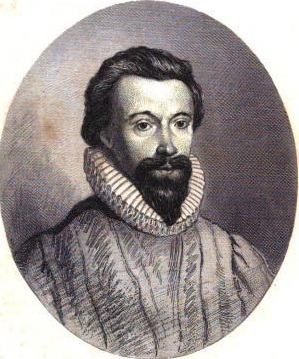About John Donne:
John Donne was born in 1572 to a Roman Catholic family in London. He is regarded as one of the most prominent metaphysical poets. Despite being greatly talented, he spent many years of his life in poverty. He went on to become an Anglican priest. He married Anne More in 1601.
About A Valediction Forbidding Mourning:
“A Valediction: Forbidding Mourning” is one of John Donne’s simplest poems, written to Anne More. He wrote it as he prepared to travel away from Anne, to Continental Europe.
Setting of A Valediction Forbidding Mourning:
The setting of this poem can be determined from the title itself. Donne is bidding farewell to his beloved wife, asking her to not mourn their separation. The poem clearly reflects how deeply he loves her. By drawing analogies between the distance between the lovers to a sheet of gold as thin as air, and the distance between the hands of a compass, Donne makes it clear to the reader of the poem that physical distance isn’t enough to disconnect him and his beloved.
Poetic Devices in A Valediction Forbidding Mourning:
Alliteration:
Stanza 1- some of their sad friends do say (line 3)
Stanza 2- tell the laity our love (line 4)
Stanza 4- Dull sublunary lovers’ love (line 1)
Simile:
(Stanza 6)
‘Like gold to airy thinness beat’ (line 4)
Here, the poet compares the love between him and his wife to a piece of gold. When beaten, gold becomes thin and spreads out. In the same way, the distance between the poet and his beloved doesn’t destroy their love, but stretches it out into something more.
(Stanza 7)
‘If they be two, they are two so
As stiff twin compasses are two’
Comparison of the distance between the poet and his wife to the distance between the hands of a compass (lines 1 and 2). In these lines, the poet conveys that even though he and his wife are apart, like the hands of a compass, they remain indivisible.
Metaphor/Personification:
In the first two stanzas, Donne compares the parting of him and his beloved to death: the parting of a soul from a body.
In stanza 3, Donne makes use of ‘trepidation’ of the earth as a metaphor to comfort his wife. He tells her that movements of huge planets do not cause any alarm, and thus she should not be bothered by their relatively small disturbance. This kind of analogy is typical of metaphysical poetry, which Donne is best known for.
In stanzas 7, 8 and 9 Donne uses the extended metaphor of the hands of a compass. He tells his wife that just as the fixed hand of the compass (his wife) and the hand that draws the circumference (Donne) are inseparable, physical distance cannot separate him and her. They will always remain connected and he will always return to her.This comparison is another metaphysical element in this poem.
Hyperbole:
Stanza 2- No tear-floods, nor sigh-tempests move (line 2) The poet tells his beloved to not create ‘tear-floods’ nor ‘sigh-tempests’. Both of these are expressions are exaggerations and are not possible.
Style of A Valediction Forbidding Mourning
As virtuous men pass mildly away, [A]
And whisper to their souls to go, [B]
Whilst some of their sad friends do say, [A]
“Now his breath goes,” and some say, “No.” [B]
Summary of A Valediction Forbidding Mourning
The poem was written in 1611 or 1612 to Anne More, the wife of the poet, as the poet was making preparations to leave to Continental Europe. It is a 36-line poem depicting what the poet feels about their separation. The poet makes heavy use of imagery and metaphors not usually used to describe love: death, gold and a compass. Here is a brief summary of the poem:
Virtuous men die without protest. The poet tells his beloved that their parting is like the death of a virtuous man, and thus she must not weep, for ‘tear-floods’ and ‘sigh-tempests’ would make their virtuous love profane. Donne comforts his wife by telling her that if the trepidations of huge celestial bodies do not cause alarm, she shouldn’t be bothered by their relatively small turbulence. Their love is refined, unlike the love of ‘dull, sublunary lovers’, which cannot survive absence of the significant other. Their minds are connected and they don’t need to bother about missing ‘hands, eyes or lips’. Their souls are inseparable, and distance cannot pull them apart. A piece of gold, when beaten, becomes a thin sheet. In the same manner, when physically apart, their love spreads over distances. Finally, the poet says, if their souls are not one but two, they are like the hands of a compass. The fixed hand may be apart from the moving hand while the moving hand draws the circumference, but in the end, they are always reunited. The poet will always return to his beloved.
Critical Analysis of A Valediction Forbidding Mourning
In ‘A Valediction: Forbidding Mourning’, John Donne draws unordinary analogies to explain to his wife the nature of their love. The point he tries to make throughout the poem is that they are spiritually bound and will always be, regardless of the geographical distance between them. He forbids her from mourning their separation. He believes that their love is so sacred that such an expression of sorrow would taint their love. Their separation is like the innocent movement of celestial bodies, and thus should cause no alarm. By calling their love ‘refined’ and comparing it to gold, Donne clearly expresses the value their love holds to him, while stating that their separation would only expand the territory of their love. As we reach the end of the poem, Donne once again uses an absurd metaphor to depict beautifully that no matter how far apart, he and his wife will be reunited in the end.
Central Idea of A Valediction Forbidding Mourning
The central idea of the poem is to look at seemingly bad situations with an optimistic point of view. Donne views the ‘separation’ of him and his lover as an ‘expansion’ (stanza 6, line 3). He explains that true love is infinite, and exists beyond earthly distances.
Tone of A Valediction Forbidding Mourning
The tone of the poem is extremely passionate. Though the poet is serious and melancholic, he remains optimistic throughout the poem. This conveys the poet’s thoughts about his love for his wife. It is mature, not extinguishable by distance and everlasting.
Conclusion-
‘A Valediction: Forbidding Mourning’ by John Donne is a poem that makes the reader realise the power of true love. It tells the reader that when two people are spiritually connected in such a way that their souls become one, one is always present with the other in spirit and physical separation ceases to matter.
Contributor: Palak Gupta
Some online learning platforms provide certifications, while others are designed to simply grow your skills in your personal and professional life. Including Masterclass and Coursera, here are our recommendations for the best online learning platforms you can sign up for today.
The 7 Best Online Learning Platforms of 2022
- Best Overall: Coursera
- Best for Niche Topics: Udemy
- Best for Creative Fields: Skillshare
- Best for Celebrity Lessons: MasterClass
- Best for STEM: EdX
- Best for Career Building: Udacity
- Best for Data Learning: Pluralsight













